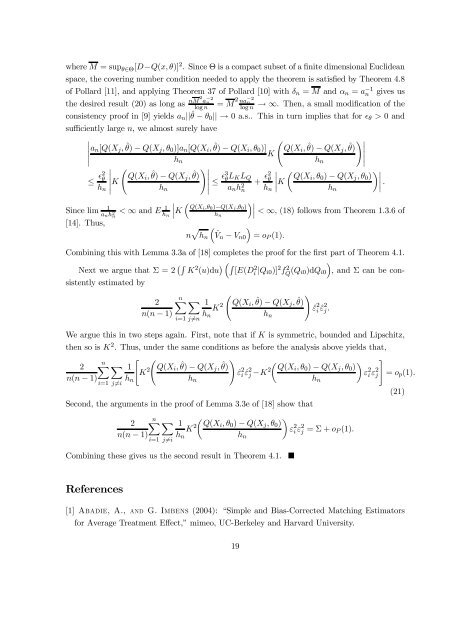On the Identification of Misspecified Propensity Scores - School of ...
On the Identification of Misspecified Propensity Scores - School of ...
On the Identification of Misspecified Propensity Scores - School of ...
You also want an ePaper? Increase the reach of your titles
YUMPU automatically turns print PDFs into web optimized ePapers that Google loves.
where M = sup θ∈Θ[D−Q(x, θ)] 2 . Since Θ is a compact subset <strong>of</strong> a finite dimensional Euclidean<br />
space, <strong>the</strong> covering number condition needed to apply <strong>the</strong> <strong>the</strong>orem is satisfied by Theorem 4.8<br />
<strong>of</strong> Pollard [11], and applying Theorem 37 <strong>of</strong> Pollard [10] with δn = M and αn = a −1<br />
n<br />
<strong>the</strong> desired result (20) as long as nM2a −2<br />
n<br />
log n<br />
= M 2 na −2<br />
n<br />
log n<br />
gives us<br />
→ ∞. Then, a small modification <strong>of</strong> <strong>the</strong><br />
consistency pro<strong>of</strong> in [9] yields an|| ˆ θ − θ0|| → 0 a.s.. This in turn implies that for ǫθ > 0 and<br />
sufficiently large n, we almost surely have<br />
<br />
<br />
an[Q(Xj,<br />
<br />
<br />
ˆ θ) − Q(Xj, θ0)]an[Q(Xi, ˆ <br />
θ) − Q(Xi, θ0)] Q(Xi,<br />
K<br />
hn<br />
ˆ θ) − Q(Xj, ˆ <br />
θ)<br />
<br />
hn<br />
<br />
<br />
<br />
<br />
K<br />
<br />
Q(Xi, ˆ θ) − Q(Xj, ˆ <br />
θ)<br />
<br />
≤ ǫ3 θLKLQ <br />
<br />
<br />
K <br />
Q(Xi, θ0) − Q(Xj, θ0) <br />
.<br />
≤ ǫ2 θ<br />
hn<br />
Since lim 1<br />
anh 2 n<br />
[14]. Thus,<br />
hn<br />
< ∞ and E 1<br />
<br />
<br />
K hn<br />
anh 2 n<br />
Q(Xi,θ0)−Q(Xj,θ0)<br />
hn<br />
+ ǫ2 θ<br />
hn<br />
n <br />
hn<br />
ˆVn − Vn0 = oP (1).<br />
hn<br />
< ∞, (18) follows from Theorem 1.3.6 <strong>of</strong><br />
Combining this with Lemma 3.3a <strong>of</strong> [18] completes <strong>the</strong> pro<strong>of</strong> for <strong>the</strong> first part <strong>of</strong> Theorem 4.1.<br />
Next we argue that Σ = 2 K2 (u)du [E(D2 i |Qi0)] 2f 2 Q (Qi0)dQi0<br />
<br />
, and Σ can be consistently<br />
estimated by<br />
n 2 1<br />
K<br />
n(n − 1)<br />
2<br />
<br />
Q(Xi, ˆ θ) − Q(Xj, ˆ <br />
θ)<br />
ˆε 2 i ˆε 2 j.<br />
hn<br />
i=1 j=n<br />
We argue this in two steps again. First, note that if K is symmetric, bounded and Lipschitz,<br />
<strong>the</strong>n so is K2 . Thus, under <strong>the</strong> same conditions as before <strong>the</strong> analysis above yields that,<br />
n<br />
<br />
2 1<br />
K<br />
n(n − 1)<br />
2<br />
<br />
Q(Xi, ˆ θ) − Q(Xj, ˆ <br />
θ)<br />
ˆε 2 i ˆε 2 j −K 2<br />
<br />
Q(Xi, θ0) − Q(Xj, θ0)<br />
ε 2 i ε 2 <br />
j = op(1).<br />
hn<br />
i=1 j=i<br />
hn<br />
Second, <strong>the</strong> arguments in <strong>the</strong> pro<strong>of</strong> <strong>of</strong> Lemma 3.3e <strong>of</strong> [18] show that<br />
hn<br />
i=1 j=i<br />
hn<br />
n 2 1<br />
K<br />
n(n − 1)<br />
2<br />
<br />
Q(Xi, θ0) − Q(Xj, θ0)<br />
Combining <strong>the</strong>se gives us <strong>the</strong> second result in Theorem 4.1. <br />
References<br />
hn<br />
hn<br />
<br />
ε 2 i ε 2 j = Σ + oP (1).<br />
[1] A, A., G. I (2004): “Simple and Bias-Corrected Matching Estimators<br />
for Average Treatment Effect,” mimeo, UC-Berkeley and Harvard University.<br />
19<br />
(21)
















